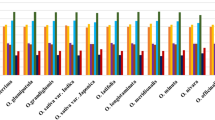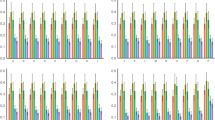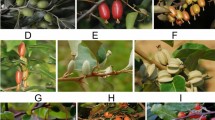Abstract
We have analyzed factors affecting the codon usage pattern of the chloroplasts genomes of representative species of pooid grass family. Correspondence analysis of relative synonymous codon usages (RSCU) showed that genes on secondary axis were correlated with their GC3S values (all r > 0.3, p < 0.05), indicating mutational bias as an important selective force that shaped the variation in the codon usage among chloroplast genes. The Nc-plot showed that although a majority of the points with low-Nc values were lying below the expected curve, a few genes lied on the expected curve. Nc plot clearly showed that mutational bias plays a major role in codon biology across the monocot plastomes. The hydrophobicity and aromaticity of encoded proteins of each species were found to be other factors of codon usage variation. In the view of above light, besides natural selection, several other factors also likely to be involved in determining the selective constraints on codon bias in plastomes of pooid grass genomes. In addition, five codons (B. distachyon), seven codons (H. vulgare), and four codons (T. aestivum) were identified as optimal codons of the three grass chloroplasts. To identify genes evolving under positive selection, rates of nonsynonymous substitutions (Ka) and synonymous substitutions (Ks) were computed for all groups of orthologous gene pairs.







Similar content being viewed by others
References
Sau, K., & Deb, A. (2008). Temperature influences synonymous codon and amino acid usage biases in the phages infecting extremely thermophilic prokaryotes. In Silico Biology, 9, 0001.
Guo, F., & Yuan, J. (2009). Codon usages of genes on chromosome, and surprisingly, genes in plasmid are primarily affected by strand-specific mutational biases in Lawsonia intracellularis. DNA Research, 16, 91–104.
Liu, Q. P., & Xue, Q. Z. (2005). Comparative studies on codon usage pattern of chloroplasts and their host nuclear genes in four plant species. Journal of Genetics, 84, 55–62.
Stenico, M., Lloyd, A. T., & Sharp, P. M. (1994). Codon usage in Caenorhabditis elegans: delineation of translational selection and mutational biases. Nucleic Acids Research, 22, 2437–2446.
Karlin, S., & Mrazek, J. (1996). What drives codon choices in human genes? Journal of Molecular Biology, 262, 459–472.
Chiapello, H., Lisacek, F., Caboche, M., & Henaut, A. (1998). Codon usage and gene function are related in sequences of Arabidopsis thaliana. Gene, 209, GC1–GC38.
Morton, B. R., & Wright, S. I. (2007). Selective constraints on codon usage of nuclear genes from Arabidopsis thaliana. Molecular Biology and Evolution, 24, 122–129.
Wang, H. C., & Hickey, D. A. (2007). Rapid divergence of codon usage patterns within the rice genome. BMC Evolutionary Biology, 7(Suppl 1), S6.
Tatarinova, T., Alexandrov, N., Bouck, J., & Feldman, K. (2010). GC3 biology in corn, rice, sorghum and other grasses. BMC Genomics, 11, 308.
Douzery, E. J. P., Snell, E. A., Bapteste, E., Delsuc, F., & Philippe, H. (2004). The timing of eukaryotic evolution: does a relaxed molecular clock reconcile proteins and fossils? Proceedings of the National Academy of Sciences USA, 101, 15386–15391.
Yoon, H. S., Hackett, J. D., Ciniglia, C., Pinto, G., & Bhattacharya, D. (2004). A molecular timeline for the origin of photosynthetic eukaryotes. Molecular Biology and Evolution, 21, 809–818.
Waters, M. T., & Langdale, J. A. (2009). The making of a chloroplast. The EMBO Journal, 28, 2861–2873.
Bendich, A. J. (2004). Circular chloroplast chromosomes: the grand illusion. The Plant Cell, 16, 1661–1666.
Sugiura, M. (1992). The chloroplast genome. Plant Molecular Biology, 19, 149–168.
Morton, B. R. (2003). The role of context-dependent mutations in generating compositional and codon usage bias in grass chloroplast DNA. Journal of Molecular Evolution, 56, 616–629.
Morton, B. R. (1998). Selection on the codon bias of chloroplast and cyanelle genes in different plant and algal lineages. Journal of Molecular Evolution, 46, 449–459.
Draper, J., Mur, L. A. J., Jenkins, G., Ghosh-Biswas, G. C., Bablak, P., Hasterok, R., et al. (2001). Brachypodium distachyon. A new model system for functional genomics in grasses. Plant Physiology, 127, 155–1539.
Bortiri, E., Coleman-Derr, D., Lazo, G. R., Anderson, O. D., & Gu, Y. Q. (2008). The complete chloroplast genome sequence of Brachypodium distachyon: sequence comparison and phylogenetic analysis of eight grass plastomes. BMC Research Notes, 1, 61.
The International Brachypodium Initiative. (2010). Genome sequencing and analysis of the model grass Brachypodium distachyon. Nature, 463, 763–768.
Zhang, W. J., Zhou, J., Li, Z. F., Wang, L., Gu, X., & Zhong, Y. (2007). Comparative analysis of codon usage patterns among mitochondrion, chloroplast and nuclear genes in Triticum aestivum L. Journal of Integrative Plant Biology, 149, 37–44.
Rosenberg, M. S., Subramanian, S., & Kumar, S. (2003). Patterns of transitional mutation biases within and among mammalian genomes. Molecular Biology and Evolution, 20, 988–993.
Wright, F. (1990). The ‘effective number of codons’ used in a gene. Gene, 87, 23–29.
Greenacre, M. J. (1984). Theory and application of correspondence analysis (p. 223). London: Academic Press.
Sharp, P. M., & Li, W. H. (1987). The codon adaptation index—a measure of directional synonymous codon usage bias, and its potential applications. Nucleic Acids Research, 15, 1281–1295.
Morton, B. R., & Levin, J. A. (1997). The atypical codon usage of the psbA gene may be the remnant of an ancestral bias. Proceedings of the National Academy of Sciences USA, 94, 11434–11438.
Kyte, J., & Doolittle, R. (1982). A simple method for displaying the hydropathic character of a protein. Journal of Molecular Evolution, 157, 105–132.
McInerney, J. O. (1998). Replicational and transcriptional selection on codon usage in Borrelia burgdorferi. Proceedings of the National Academy of Sciences USA, 95, 10698–10703.
Ikemura, T. (1985). Codon usage and tRNA content in unicellular and multicellular organisms. Molecular Biology and Evolution, 2, 13–34.
Polzin, K. M., Calvo, E. S., & Olsona, T. S. (1998). Identification of homoeologous regions in complex genomes using lambda genomic clones. Plant Science, 131, 161–171.
Lyons, E., Pedersen, B., Kane, J., Alam, M., Ming, R., Tang, H., et al. (2008). Finding and comparing syntenic regions among arabidopsis and the outgroups papaya, poplar, and grape: CoGe with Rosids. Plant Physiology, 148(4), 1772–1781.
Popendorf, K., Hachiya, T., Osana, Y., & Sakakibara, Y. (2010). Murasaki: a fast, parallelizable algorithm to find anchors from multiple genomes. PLoS ONE, 5(9), e12651.
Pevzner, P. A., & Tesler, G. (2003). Genome rearrangements in mammalian evolution: lessons from human and mouse genomes. Genome Research, 13, 37–45.
Bourque, G., Pevzner, P. A., & Tesler, G. (2004). Reconstructing the genomic architecture of ancestral mammals: lessons from human, mouse, and rat genomes. Genome Research, 14, 507–516.
Sakakibara, Y., Osana, Y., & Popendorf, K. (2007). Development of a large-scale comparative genome system and its application to the analysis of mycobacteria genomes. Nihon Hansenbyo Gakkai Zasshi, 76, 251–256.
Hachiya, T., Osana, Y., Popendorf, K., & Sakakibara, Y. (2009). Accurate identification of orthologous segments among multiple genomes. Bioinformatics, 25, 853–860.
Grigoriev, A. (1998). Analyzing genomes with cumulative skew diagrams. Nucleic Acids Research, 26, 2286–2290.
Tatarinova, T., Brover, V., Troukhan, M., & Alexandrov, N. (2003). Skew in GC content near the transcription start site in Arabidopsis thaliana. Bioinformatics, 19(Suppl 1), i313–i314.
Wan, X. F., Xu, D., Kleinhofs, A., & Zhou, J. (2004). Quantitative relationship between synonymous bias and GC composition across unicellular genomes. BMC Evolutionary Biology, 4, 19.
Larkin, M. A., Blackshields, G., Brown, N. P., Chenna, R., McGettigan, P. A., McWilliam, H., et al. (2007). Clustal W and clustal X version 2.0. Bioinformatics, 23, 2947–2948.
Sueoka, N. (1999). Translation-coupled violation of parity rule 2 in human genes is not the case of heterogeneity of the DNA G+C content of third codon position. Gene, 238, 53–58.
Sharp, P. M., Cowe, E., Higgins, D. G., Shields, D. C., Wolfe, K. H., & Wright, F. (1988). Codon usage in Escherichia coli, Bacillus subtilis, Saccharomyces cerevisiae, Schizosaccharomyces pombe, Drosophila melanogaster and Homo sapiens; a review of the considerable within-species diversity. Nucleic Acids Research, 16, 8207–8711.
Knight, R. D., Freeland, S. J., & Landweber, L. F. (2001). A simple model based on mutation and selection explains trends in codon and amino-acid usage and GC composition within and across genomes. Genome Biology, 2, 0010.1–0010.13.
Coulondre, C., Miller, J. H., Farabaugh, P. J., & Gilbert, W. (1978). Molecular basis of base substitution hotspots in Escherichia coli. Nature, 274, 775–780.
Hasegawa, M., Cao, Y., & Yang, Z. (1998). Preponderance of slightly deleterious polymorphism in mitochondrial DNA: nonsynonymous/synonymous rate ratio is much higher within species than between species. Molecular Biology and Evolution, 15, 1499–1505.
Sueoka, N. (1962). On the genetic basis of variation and heterogeneity of DNA base composition. Proceedings of the National Academy of Sciences USA, 48, 582–592.
Morton, B. R. (1999). Strand asymmetry and codon usage bias in the chloroplast genome of Euglena gracilis. Proceedings of the National Academy of Sciences USA, 96, 5123–5128.
Meng, Z., Wei, L., & Xia, L. (2008). Analysis of synonymous codon usage in chloroplast genome of Populus alba. Journal of Forestry Research, 19, 293–297.
Pfitzinger, H., Guillemaut, P., Weil, J. H., & Pillay, D. T. N. (1987). Adjustment of the tRNA population to the codon usage of chloroplasts. Nucleic Acids Research, 15, 137.
Shi, X. F., Huang, J. F., Liang, C. R., Liu, S. Q., Xie, J., & Liu, C. Q. (2001). Is there a close relationship between synonymous codon bias and codon-anticodon binding strength in human genes? Chinese Science Bulletin, 12, 1015–1019.
Xia, X. (1998). How optimized is the translational machinery in Escherichia coli, Salmonella typhimurium and Saccharomyces cerevisiae? Genetics, 149, 37–44.
Lynn, D. J., Singer, G. A., & Hickey, D. A. (2002). Synonymous codon usage is subject to selection in thermophilic bacteria. Nucleic Acids Research, 30, 4272–4277.
Wolfe, K. H., & Sharp, P. M. (1988). Identification of functional open reading frames in chloroplast genomes. Gene, 66, 215–222.
Morton, B. R. (1993). Chloroplast DNA codon use: evidence for selection at the psbA locus based on tRNA availability. Journal of Molecular Evolution, 37, 273–280.
Zhao, S., Zhang, Q., Chen, Z., et al. (2007). The factors shaping synonymous codon usage in the genome of Burkholderia mallei. Journal of Genetics and Genomics, 34, 362–372.
Hausner, G., Olson, R., Simon, D., Johnson, I., Sanders, E. R., Karol, K. G., et al. (2006). Origin and evolution of the chloroplast trnK (matK) intron: a model for evolution of group II intron RNA structures. Molecular Biology and Evolution, 23, 380–391.
Selvaraj, D., Sarma, R. K., & Sathishkumar, R. (2008). Phylogenetic analysis of chloroplast matK gene from Zingiberaceae for plant DNA barcoding. Bioinformation, 3, 24–27.
Wolfe, K. H., Morden, C. W., Ems, S. C., & Palmer, J. D. (1992). Rapid evolution of the plastid translational apparatus in a non-photosynthetic plant: loss of accelerated sequence evolution of tRNA and ribosomal protein genes. Journal of Molecular Evolution, 35, 304–317.
Boudreau, E., Takahashi, Y., Lemieux, C., Turmel, M., & Rochaix, J. D. (1997). The chloroplast ycf3 and ycf4 open reading frames of Chlamydomonas reinhardtii are required for the accumulation of the photosystem I complex. The EMBO Journal, 16, 6095–6104.
Magee, A. M., Aspinall, S., Rice, D. W., Cusack, B. P., Sémon, M., Perry, A. S., et al. (2010). Localized hypermutation and associated gene losses in legume chloroplast genomes. Genome Research, 20, 1700–1710.
Acknowledgments
Gaurav Sablok thanks Key Lab of Horticultural Plant Biology (MOE), Huazhong Agricultural University. Tsuyoshi Hachiya and Yasubumi Sakakibara of Department of Biosciences and Informatics, Faculty of Science and Technology, Keio University, Japan are gratefully acknowledged for chrom-link visualization of the genomes. We gratefully acknowledge Professor Hans K. Stenoien, Systematics & Evolution Group, Norwegian University of Science and Technology, Norway for providing the peer review eye during the manuscript preparation. This work was supported by the Department of Biotechnology, Ministry of Science and Technology, Government of India. Research work of F. Vazquez is supported by an Ambizione Grant (PZ00P3_126329/1 to F.V.) of the Swiss National Science Foundation. Tatiana Tatarinova would like to thank the University of Glamorgan’s Research Investment Scheme for supporting this project.
Author information
Authors and Affiliations
Corresponding authors
Electronic Supplementary Material
Below is the link to the electronic supplementary material.
Rights and permissions
About this article
Cite this article
Sablok, G., Nayak, K.C., Vazquez, F. et al. Synonymous Codon Usage, GC3, and Evolutionary Patterns Across Plastomes of Three Pooid Model Species: Emerging Grass Genome Models for Monocots. Mol Biotechnol 49, 116–128 (2011). https://doi.org/10.1007/s12033-011-9383-9
Published:
Issue Date:
DOI: https://doi.org/10.1007/s12033-011-9383-9




